万字长文,Brice Morrison解构游戏设计的五个层面上篇
作者:Brice Morrison
分析游戏设计标准之核心体验
制作出一款非常成功的游戏只是因为运气?或者因为你使用了一些系统化的方法?是否那些能让我们感到开心并能够丰富生活的游戏只是开发者运气或正确决策的产物?是否有哪 种方法能够用来分析成功游戏的优劣?并将其真正落实到你自己的游戏中去。
我认为这些问题的答案是肯定的:即我们可以去策划,学习,并按照可靠的范例去设计并开发游戏。一些成功的公司,如任天堂,Valve,Zynga以及暴雪也会同意这个答案。一些 传奇游戏的设计者,如宫本茂,Will Wright以及Peter Molyneux也可能会赞成这个答案。这些公司或者开发者都找到了合适的方法而让他们能够一年接着一年推出大受欢迎的游戏 。因为如果你的第三款或第四款游戏都能够取得好成绩了,那么这种成功便不再是巧合或运气了。
通过分析过去几年的那些独立游戏和公司巨作,我发现了设计与学习游戏还是有一套标准的方法。即使是游戏产业发生了变化也不会破坏这个标准。新的公司,新的类型,新的控 制器都不会改变它。不论是独立游戏还是公司游戏,这些标准都是一样的。那是一套不可改变的系统准则,而很多开发者经常会无知地忽视它。
这个方法被称为游戏设计标准,通常由五个不同的部分所组成:核心体验,基础机制,奖惩系统,长期动机以及美学布局。游戏设计的目标是提供给开发者,包括独立开发者以及 游戏开发老手们一个有力的分析和规划工具,并帮助他们去分析游戏的优劣从而学习并完善其未来的游戏。
这篇文章只是对于游戏设计标准的初步介绍,为那些不了解这个概念的开发者做出解释。而首先我们要先关注其中最重要的一部分,即核心体验。
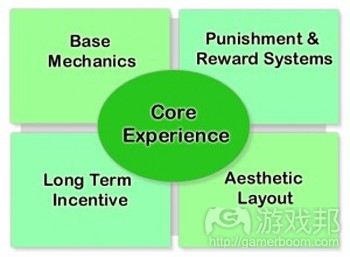
game-design-canvas(from thegameprodigy)
关于游戏设计标准的概述
游戏设计标准是个用于分析并规划游戏极其发展的工具。通过使用它去定义成功游戏和失败游戏,我们能够更容易地掌握影响游戏成功或失败的因素。一旦我们理解了这个概念, 那么开发者便能够使用它去找到适合自己游戏的设计方法了。
游戏设计标准可以用来分解那些包含不同游戏的系统,并判断它们的构成要素是什么。正如上述所说,游戏设计标准是由五大因素构成:
核心体验-玩家在玩游戏时有何体验?
基础机制-玩家到底在做些什么?
奖惩系统-玩家在游戏中的哪种行为应该得到鼓励或者批评?
长期激励-是什么激励玩家继续玩游戏?
美学布局-游戏设置是如何体现视觉和音效?
在今后的一些文章中我们将以一些使用了游戏设计标准的游戏为例子,进一步研究这五个构成因素。而现在,我们先来讨论这五个因素中最重要的:核心体验。
什么是核心体验
孔子曾经说过:“听而易忘,见而易记,做而易懂。”
核心体验是每一款游戏的核心内容。玩家能够在游戏过程中由内而发地感受到这种体验。核心体验之所以重要,是因为每一款游戏的目的都是向玩家传输体验。明确定义了核心体 验的游戏将能够提供给玩家更多乐趣,并因此赢得利润。
真实的核心体验可以由开发者自行决定时间。同时开发者也可以选择提供抽象的核心体验。
作为一名军人在战争中战斗(游戏邦注:《使命召唤》,例子在下文详述)
不断锻炼而成为一个健康的人(《Wii Fit》)
就像一次有趣的探险(《塞尔达传说》)
成为一名懂得社交的农场主(《FarmVille》)
以另外一个人的身份生活(《模拟人生》)
成为警员或者罪犯(《侠盗猎车手》)
生活中的每一个碎片都是一种体验。而游戏也正是在研究如何将生活中的典型片段(按照开发者的兴趣)融入到游戏中,并让玩家感受到这些体验。书籍,电影和其它媒体也在尝 试着这么做。它们将读者带进一个生动的爱情故事中,或者让观众能够体验场景中的奋斗场面。而游戏与之相比做得更好,因为它让玩家能够采取行动,并真正加入游戏中,成为 该体验的一部分。
如果一款游戏成功地向玩家传达了这种核心体验,那么它便能够预测到玩家对于游戏的评价。开发团队应该清楚自己理想中的核心体验,而如此他们在开发过程中所做出的任何决 策便都会体现该体验了。完全忠实于核心游戏体验的游戏开发能够造就一款优秀的艺术品。
核心体验的历史:从象棋到第一人称射击游戏
我们认为,一个好的核心体验必须是真正吸收了现实生活中的某些方面。当然了,一切皆有可能,在游戏产业中也因为一些趋势和偏好而构成了我们现在的游戏方向。让我们纵观 核心体验的发展历史从而更好地理解我们今天所看到的核心体验。
早前的游戏或者体育运动中总是在表达一些冲突的理念。在很久很久之前,当计算机时代刚刚来临之时,象棋和击剑便是传统游戏的最佳例子,并与早前的游戏有一些相似之处。 这些游戏的核心体验都围绕着战斗;如象棋模拟了策略战争,让玩家在游戏中做决策,并为了获得最后胜利而必须做出牺牲。而击剑游戏则为玩家再现了中古战场那种一对一搏斗 的场景。
同样的,与游戏一样的活动,如跳舞或音乐也有很长的一段历史。这类型的活动远离了冲突,充满了各种和谐感,注重参与者间的交流。小提琴手随着鼓手的节奏拉着琴,并反复 进行这种节拍。跳舞时,领舞的一方需要轻柔地拉着对方在舞厅里来回旋转滑行,而在整个过程中无需任何的言语交流。当对方也同步感受到相同的喜悦时,核心体验便成功了, 这就是一种让两个或者更多人体验到相同感受的概念。
在70年代,当电脑辅助的视频游戏横空而降而投币的游戏机也渐渐开始走红之时,游戏开始趋向于关注挑战体验了。包括人与机器以及人与人之间的挑战。《Pong》以及《太空入 侵者》吸引了玩家长达一个季度的关注便证明了它的魅力。在游戏中,几乎所有玩家都能够登上高分排行榜中,并且都能够展示自己的技巧和才能。这时候游戏的核心体验来自于 玩家战胜了自己并战胜了游戏中的挑战,也就是战胜了之前玩家的游戏成绩。在这种投币游戏产业里,玩家的能力对于核心体验有很大的影响,而这类型的游戏直到90年代仍然大 受欢迎,即使它们的设计已经不再适应时代变化了。
在八九十年代,比起个人的高分表现,游戏开始以更广泛的标准去区分核心体验。在当时最受欢迎的角色扮演游戏,如《最终幻想》或者《塞尔达传奇》都更加侧重于故事描述, 而非玩家的自我表达。这些游戏都迫使玩家去听一些关于骑士或农民在过去的探险或者未来发展的一些悲惨故事。所以这个时期游戏的核心体验是侧重于模仿不同的故事。开发者 通过开发游戏角色,勾画游戏世界,添加游戏故事(美学布局)等去创造这种体验。通过扩展这种核心体验的可能性,开发者能让玩家在虚构的游戏世界中进行一些有意义的行动 ,并让他们能够尝试自己从未尝试过的东西。
从2000年以来,游戏有了进一步的发展,并开始呈现给玩家更广泛的游戏体验了。紧随着90年代的游戏传统,这个时候的游戏希望玩家能够感受到与现实世界不一样的游戏体验, 而且因为技术的进步使得这种体验也比早前的游戏更具有吸引力。在这个时代里,《侠盗猎车手》与《孢子》也比早前的系列更具有真实性了。包括水,烟,建筑,人群,人类和 非人类,音效等都比之前更加真实,但是核心体验却保持不变,即讲故事,进行冒险,完成任务,反败为胜。
其它现代游戏也力求将玩家的真实生活片段带进核心体验中。Wii Fit同时也帮助我们丰富了游戏以外的生活。玩家在游戏中不再仅仅为了获得高分而努力或者只是一味地想要沉浸 在虚构的游戏故事中,反而他们更能够从中去品味并改善自己的现实生活。
核心体验案例:《使命召唤:现代战争2》
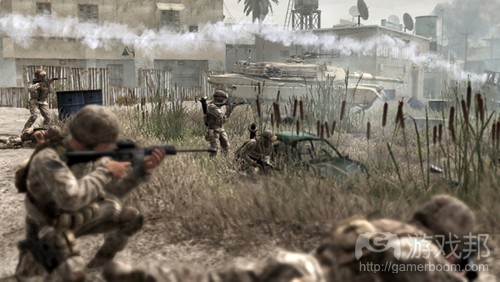
使命召唤:现代战争2(from inquisitr.com)
《使命召唤》是一款成绩显赫的系列游戏。凭借广告宣传而最新发行的那个系列堪称是游戏产业中最大且最具侵略性的游戏,即单在游戏发行的第一天就获得了超过470万的销量。 取得如此好成绩便是因为这款游戏意识到核心体验的重要性,始终坚持落实核心体验,将其贯穿于游戏始终。
《现代战争2》有一个非常严格的核心体验:当前作为一名士兵。这是所有接触游戏的玩家都能够感受到的体验。与相同类型的其它游戏相比,这款游戏凭借销量和玩家的称赞,无 可厚非是位优胜者。游戏中的点点滴滴,包括喷射机翱翔云霄(美学),游戏的得分结构和武器(奖惩系统),多人模式中的排名系统和晋升体系(长期的激励)等所有方面都支 撑着游戏的核心体验。
针对于游戏中的每个功能,你都要自问:“如何做才能让玩家感受到这些功能?”答案都一样:必须让玩家感受到自己就是在战场上战斗的士兵。
游戏中的方方面面都应该重视这个问题,因此游戏才能得到玩家的喜爱。如果这些附加功能在游戏开发过程中就已经存在着,那么电子游戏开发商Infinity Ward的开发小组一定不 会让它们一直延续到成品游戏的身上。因为游戏的制作始终强调着一致性。
让玩家能够坐在起居室的沙发上手握游戏控制器便能够感受到与恐怖组织之间的战斗,那么这真的是一个伟大的创举。这种对于人脑的“欺骗”只能是那些特定且明确的核心体验 能够给予的,而且也必须得到游戏设计标准的其它四大因素的支持。《使命召唤:现代战争2》正是为玩家呈现出了力量与控制这种核心体验,所以才能取得如此巨大的市场份额。 如果一款游戏能够描写它的体验并根据游戏设计标准去分析这种体验,那么它的成功便不再是话下了。
核心体验对推广和销售的影响
核心体验是游戏设计标准的中心内容,因为它能够影响游戏中的每一个方面。游戏的基础机制,奖惩系统,长期激励以及美学都是围绕着核心体验而发展变化。如果游戏的核心体 验平淡无奇,那么其它因素亦然。因此,不仅是游戏开发团队对于游戏的核心体验充满兴趣,市场营销团队也同样对其充满好奇。
当你完成了一款游戏并打算将其投放市场供全球的玩家下载时,你应该回答玩家一个问题,即“游戏的核心体验是什么?”如果玩家听说一款游戏很“优秀”,那么他们也不会仅 仅依靠这种评价便去购买游戏。玩家需要知道自己能够从游戏中获得何种体验。是忍者探险还是阅读导师?不论你提供的是何种游戏体验,这都将成为游戏销售的市场营销口号。 玩家关于游戏的每一个评价都与游戏体验有着直接的联系。
游戏设计应优先确定核心体验
最后,游戏的成功与失败都是基于它们对于核心体验的选择,而核心体验执行的成败更是归结于对游戏设计标准其它因素的贯彻。基础机制,奖惩系统,长期激励以及美学布局都 深深扎根于游戏中,并随着核心体验的发展而发展。这就是为何定义核心体验对于开发团队来说是如此重要了。而且这也是游戏开发中的首要任务,如果你发现自己的首次尝试是 错误的,那你就需要去调整它并因此改变其它因素。如果没有了核心体验,而只是把游戏设计标准的其它四个因素之一当成最重要因素,即使创造出震撼人心的视觉效果或者扣人 心弦的游戏故事,但是最后的一切也不会有多大意义。
如果你的游戏并不能让玩家感受到核心体验,那么再棒的游戏内也不可能让其取得成功。即使玩家会在评论中赞扬你的图像,音乐或者音效(美学),但是整体的游戏乐趣也只 能是平淡无奇了。
然而,如果你能很好地定义游戏的核心体验,并竭尽全力为玩家创造这种体验,而且这也是玩家心目中的理想体验,那么游戏的成功便是指日可待了。
分析游戏设计标准之基础机制
Dave目前正在着手自己的大型独立游戏。他已把握题材和总体构思。这是款有关僵尸的动作/冒险游戏,玩家吸收受害者的血液。玩家得避免日光曝晒,游戏涉及浪漫爱情故事。听 起来是款不错的游戏。
他向业内好友陈述自己的想法。他的激动之情溢于言表,他非常喜欢僵尸吸血这个游戏。但当好友问及:
“玩家如何盗取血液?”
Dave告知好友僵尸可以瞄准任何人,吸取他们的血液,这就是游戏的运作方式。但好友反复表示,“玩家点击什么按键?你如何通过按键点击传递僵尸盗取他人血液的信息?”
Dave低头不语,发现自己的构思虽然理论上看颇为有趣,但有些操之过急。
巧妇难为无米之炊
Dave的构思也许非常不错,但能否最终实现?这要看情况;构思都很好,但其中缺乏组织关系。Dave没有腾出时间创建游戏基础;他只是从某些有趣故事下手。若Dave草率动手, 未先创建联系,就开始根据构思编码,游戏最终很可能只是款同其他作品大同小异的普通之作。也就是说游戏难成为轰动巨作。
要想构建僵尸体验,Dave需在制作初期思考基础机制。
就如之前提到的是,本系列的“游戏设计标准”是个分析和规划方式,游戏开发者可以凭此设定游戏轮廓、目标和用户体验。通过运用这些标准,设计师能够围绕预期核心体验创 建游戏内容。
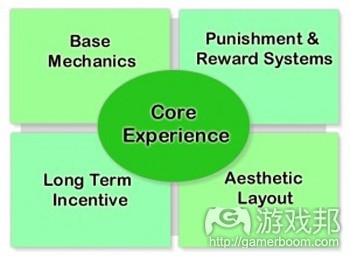
game-design-canvas(from thegameprodigy)
通过这一系列的游戏设计标准,设计师、开发商和用户能够描述和分析游戏的核心要素。此前我们就已谈及核心体验的重要性,就是开发者希望用户体验游戏时收获的感觉。本文 主要谈论基础机制。
不妨先来看看一个类比例子。房子由砖块砌成。大家走进房子的时候不会想到砖块、木头和管道。新屋主不会像好友吹嘘房子使用什么泥浆;他们期望瞄准其他更优的元素!他们 希望展示时髦木质地板、大理石案台,或者多层供暖设备。砖块是基础元素,若砖块的堆砌方式不当,那么其他都免谈。
同样,游戏也是由基础机制构成。这些机制是玩家的实际操作活动。当玩家点击按键时,屏幕就会出现反应。当玩家移动鼠标时,游戏就会出现变化。当玩家移动Wii遥控或其他输 入装置时,目标就会出现变化。这些互动是组成游戏的要素,非常重要。矛盾的是,玩家通常不会过多考虑游戏机制。要想呈现高质量作品,开发商就必须专注于这些“砖块”。
基础机制
基础机制是一组玩家操作&反应活动。虽然玩家考虑的也许是游戏故事、关卡目标,或其他设计标准中的高级元素,但他们每时每刻进行的内容都能够通过基础机制陈述。丧失基础 机制,玩家就没有可操作的内容。
游戏需要玩家同内容进行互动。若玩家未同内容进行互动,他们就不是在体验游戏,他们只是观察内容,并没有参与其中。玩家的互动内容很多(游戏邦注:就现代游戏而言,主 要是按键的点击;就运动控制游戏而言,主要是遥控手势)。除电子游戏外,还有运动游戏的活动操作,棋盘游戏的移动操作。这些是玩家采取行动影响游戏内容的体现。
游戏具有象征性。游戏赋予某些活动特殊意义。若我拾起木制小人,在桌面移动,这个活动没有意义。但若是在国际象棋游戏背景下,这个操作的意义是我通过小兵进攻对手。
基础机制具有各种类型。要想正确运用至游戏,我们需要把握这些类型的具体内容。
原子基础机制
有些基础机制呈原子形式,也就是说它们是游戏中最小的动作&效果组合。这通常是单个按键点击或手势,这也可能更复杂些,取决于游戏。重点是,在游戏游戏规则中,这些动作 无法分解成更小内容。
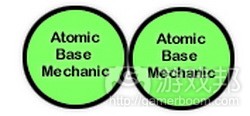
Atomic Base Mechanic from thegameprodigy.com
在《宝石迷阵》中,玩家需点击不同宝石,交换它们的位置,将3个同类宝石排成一列。这里的原子基础机制是玩家点击单个宝石。玩家点击产生的反应是宝石移动。虽然这款游戏 已被各类玩家玩过数亿小时,所有玩家活动都是点击宝石,然后移动。整个过程反反复复。
《Wii Sports Tennis》的原子机制是玩家摇摆Wii遥控,令角色挥动球拍。玩家通过此行为体验各场比赛。
许多游戏都由极少原子基础机制构成。上述两个例子只有一个原子机制。即便是复杂现代游戏最多也只有3-4个原子基础机制。战斗游戏包含攻击、防卫和移动。第一人称射击游戏 通常包含进攻、防卫,运用魔法和道具。这些游戏也许会粉饰这些元素,将其变成复杂链条,但玩家进行的原子操作通常非常简单。
原子基础机制非常有趣,因为他们以略显无趣的科学方式呈现游戏。虽然制作游戏的目标是获得核心体验(游戏邦注:体现在玩家感受),但实际组成“砖块”通常没有整体内容 那般有趣。思考下列游戏的趣味性:
* 你所要进行的操作是移动球体,试图将其射入特定区域
* 点击某物,然后选择期望互动方式。这就是游戏。
* 所进行的内容是阅读文本,基于不同选择进行抉择。
不是很有趣,是吧?但它们是某些倍受欢迎游戏的原子机制。
* 足球运动
* 《模拟人生》
* 《最终幻想》,或经典RPG游戏
这些例子说明我们不能够通过原子基础机制描述评判游戏。这就好比阅读许多关于某人的事迹后称自己了解此人。“此人有棕色头发,身材颇高,喜欢烘培。你喜欢他吗?”这是 电脑的思维方式,但人类会更深入地思考。只有待到我们深入下层基础机制,游戏的核心体验才会开始显现出来。
复杂基础机制
原子基础机制非常重要,但游戏的内容当然远不止奔跑和跳跃活动。玩家奔跑于拥挤城市,努力向上跳跃,同时确保头部不触及建筑顶部。他们奔跑越过缝隙,然后跃至3个敌人之 上。他们持续奔跑,然后停下等待守卫穿过,然后继续奔跑。
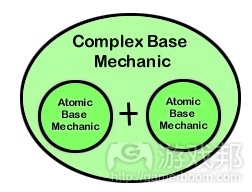
Complex Base Mechanic from thegameprodigy.com
复杂基础机制形成于各种原子机制绑定起来创造新内容。玩家通常只有在掌握潜在原子机制后才能把握这些新行为。游戏会告知他们,或给予充足时间,让他们自己发现。
在《宝石迷阵》中,我们曾谈到游戏的原子基础机制是玩家点击两个宝石,交换它们的位置。这令玩家得以串联3个宝石。但若玩家连接的宝石超过3个?通过点击宝石将其放置于 合适位置!若它们形成链条,玩家将获得额外较高积分!通过以特定方式执行原子基础机制,玩家能够完成创建链条的复杂基础机制。
在国际象棋中,开旗法是指玩家故意牺牲某棋子换得长远优势。例如,他们可以将小兵放于易受攻击的位置,因为当对手拿下小兵后,他们将处在更加危险的位置。象棋的原子机 制并未涉及此概念。这属于复杂机制概念,结合若干原子机制创造更加有趣的内容。
开发商如何支撑复杂机制完全取决于他们自己。例如,在复杂游戏中,玩家能够奔跑和跳跃,所以当然他们也能够通过同时奔跑和跳跃到达新 高度。开发商可以让玩家通过既有原 子机制完成此操作,或者他们可以选择添加额外内容,从而使跳跃+奔跑组合操作能够让玩家跳得更高,并伴有新的特效和音效(游戏邦注:开发商如何创造此内容及其他复杂基础 机制完全取决于他们自己)。
全局视角
基础机制是游戏的构建模块,但它们主要依赖于游戏设计标准中的其他元素。虽然它们组成玩家所操作的活动,占据玩家所有体验时间,但仅由基础机制构成的游戏相当乏味。
游戏奖惩系统赋予玩家行为含义;玩家如何知晓操作什么内容及何时进行?这些机制应通过什么方式进行运用和优化?长期奖励促使玩家继续饶有兴致地反复操作这些基础机制。 美学布局给予玩家行为此刺激因素:当玩家以正确顺序完成操作时给予玩家漂亮的“结合物!”所有这些要素都同基础机制及玩家行为联系密切,赋予操作相应意义,促进传递核 心体验。
“千里之行始于足下”
就像古话说的,“千里之行始于足下”。同样,游戏也是一步一步构建而成,由各个基础机制组成。持续支持核心体验和基础机制能够给各游戏创造构建模块,引导玩家的各体验 时刻。若这些“砖块”组建合理,将创造惊人体验时刻。
相关拓展阅读;篇目1,篇目2(本文由游戏邦编译,转载请注明来源,或咨询微信zhengjintiao)
The Game Design Canvas: An Introduction
by Brice Morrison
Do astronomically successful games happen by chance, or can their approach be systematized? Are the games that make us laugh, gasp, and enrich our lives results of the developers getting lucky, or careful decision making? Is there a way to analyze successful games to understand where their strengths and weaknesses lie, and then apply them to your own games?
I believe that the answer to these questions is yes: a game’s design and development can be mapped out, studied, and perfected in a reliable fashion. Successful companies like Nintendo, Valve, Zynga, and Blizzard would agree. Legendary game designers like Shigeru Miyamoto, Will Wright, and Peter Molyneux would likely agree as well. These companies and developers have found ways of looking at games that lets them consistently crank out hits year after year after year. By the time you get to the third and fourth blockbuster, it is no accident.
Through analyzing countless independent and corporate titles over the course of the last several years, I’ve come to believe that there is a standard way of designing and studying games. Changes in the industry don’t disrupt it. New companies, new genres, and new controllers don’t change it. Independent or corporate, these rules are the same. These are systemic laws that are immutable. Developers ignore them at their own risk.
This approach is called the Game Design Canvas. It is made up of five different components: The Core Experience, Base Mechanics, Reward and Punishment Structures, Long Term Incentive, and Aesthetic Layout. The Game Design Canvas’s goal is to provide a powerful analytical and planning tool for developers, independent and industry veterans alike. All games have aspects that can be represented in the Canvas, and through it, it is possible to analyze the strengths and weaknesses of any game for the purposes of study and improvement on future projects.
This article will serve as an introduction to the concept of using the Game Design Canvas for developers who aren’t familiar with it. From there we’ll focus on the most influential part of the Canvas, the Core Experience.An Overview of the Game Design Canvas
The Game Design Canvas is a tool that can be used to analyze and formulate games and their development. By using it to firmly define the component of both successful and unsuccessful game titles, we can gain a great understanding of what makes the game tick, or what caused it to fail. Once we understand that, developers can use the Canvas to find a design approach for their own games.
The Game Design Canvas can be used to break down the systems that comprise different games and determine the aspects that make them what they are. As stated, the Canvas is made up of five major components:
Core Experience – What is the player experiencing as they play the game?
Base Mechanics – What does the player actually do?
Punishment and Reward (P&R) Systems – What behavior within the game is encouraged or discouraged?
Long Term Incentive – What causes the player to continue to play?
Aesthetic Layout – How is the setting represented through sight and sound?
In future posts we’ll be applying the canvas to several game titles as illustrations, as well as delving into the specifics of each of the five components. For now, let’s get started by going into the most important of the five components: the Core Experience.
What is the Core Experience
“I hear, and I forget. I see, and I remember. I do, and I understand.” – Confucius
At the center of every game is the Core Experience. This is the feeling that the game is trying to evoke, the .inner emotion that the player is going through as they play. The Core is vitally important, because conveying an experience is the purpose of every game. Games that have a well defined Core Experience and are able to bring it to fruition more often enjoy critical acclaim and financial success.
Examples of solid Core Experiences can be any moment or period of time the developer chooses. It can also be an abstract notion or feeling.
Fight as a soldier in war (Call of Duty; example below)
Be a healthy person who is getting in shape (Wii Fit)
Feel like a clever adventurer (Legend of Zelda)
Be a sociable farm tender (Farmville)
Live the life of a different person (The Sims)
Be a vigilante or a criminal (Grand Theft Auto)
All of life is an experience. Games specialize in taking a slice of life (as narrow or wide as the developers likes) and then allowing the player to feel and exist in that slice for a period of time. Books, film, and other media attempt to do the same thing. They drop the reader into a short lived romance, or allow the viewer to observe a struggle. Games go one step further in demanding that the player take action and be a part of the experience.
A game that succeeds in delivering its core experience will be able to predict how its players will describe it before they open their mouths. The development team will be intimately familiar with their desired Core Experiece, and their decisions during production will reflect that familiarity. Games developed with a strong loyalty to their Core Experience are admirable works of art.
History of Core Experiences: From Chess to First Person Shooters
We’ve stated that a good Core Experience can be a sampling of anything that can be described in life. Of course anything is possible, but there are trends and favorites in our industry that have shaped the direction of games up until the present. Let’s take a quick detour through the history of Core Experiences in order to better understand where we stand today.
Ancient games and sports have always had games which expressed the concept of conflict. Chess and fencing are both examples of traditional games long before the age of the computer that bared many resemblances. Each of their Core Experiences are dedicated to struggle; chess emulated the strategy of war, of making difficult decisions and forcing sacrifice to attain overall victory. Fencing recreated the feeling of one on one combat found in the medieval battlefield.
Likewise, game-like activities such as dancing or music are as old as writing. Far fromconflict, these types of games were influenced by harmony, simulating the feeling of cooperation and communication with another. The fiddler follows the drummer and they play back and forth. The lead gently pushes his follow to and fro, twirling and gliding around the ballroom without exchanging so much as a word. The Core Experience was one of enjoyment of another’s synchronicity, of two or more people becoming one.
In the 70’s, when computer-aided video games came into being and the coin-slot industry was taking off, games were focused on the experience of a challenge. Man versus the machine and man versus himself. Pong and Space Invaders beckoned the player insert one more quarter to prove his worth. Almost every game boasted a high score list, an opportunity to display skill and mastery. The Core Experience of games from this age was one of mastery over self and over a well defined challenge, of competing against the history of players before. So strong was the influence of this Core Experience over the coin-slot industry that many games retained high score counters well into the 90’s, long after their designs had rendered them useless.
In the 80’s and 90’s, games began to branch into broader Core Experiences than the player’s personal high score. The most popular role playing games such as Final Fantasy or the Legend of Zelda were used to tell stories greater than the players themselves. They whisked the player away to hear the harrowing tale of knights and peasants, of adventurers from past and future worlds. In this age of games, the Core Experience was to emulate the tale of another. Developers did this by developing characters, painting worlds and adding back stories (Aesthetic Layout). By broadening the possibilities of their Cores, they gave the actions of the player meaning within the fictional world of the game and took players to places they had never been before.
Since 2000, games have taken further leaps and have begun to express a much larger range of experiences. Games that follow the tradition of the 90’s to help the player feel what it’s like to live the tale of another are able to do so with much more immersion than ever before thanks to increases in technology and processing power. The Grand Theft Auto’s and Spore’s of the day appear more real than their ancestors. Water, smoke, buildings, crowds, humans, and non-humans look and sound more real than ever before, while the Core Experience remains the same. Tell a story, go on an adventure, complete the mission, save the day.
Other modern games seek to pull the Core Experience back to the player’s real life. The Wii Fit’s of the world help us improve our lives outside of the game. They provide the player with the feeling of improvement in one’s own life, of striving towards a goal that is more than a high score or a fictional tale.
Effective Core Experience Example: Call of Duty Modern Warfare 2
Call of Duty is an astonishingly profitable series. The latest title released was dubbed the largest and most aggressive game launch in terms of advertising the industry has ever seen, resulting in over 4.7 million units sold in the first day alone. Clearly they have found a Core Experience that is popular and have been able to stick to their guns, making sure that everything in the game was married to that Core.
Modern Warfare 2 has a very firm Core Experience: being a soldier in war in the present day. This is the feeling that all players should have when they play the games. Among other games in this genre, they are the undisputed winner in terms of both sales as well as critical acclaim. Everything in the game, the bombers soaring overhead (Aesthetic), the game scoring structures and weapons (P&R System), the ranking systems and promotions dolled out in multiplayer
(Long Term Incentive), all of these aspects serve to bolster this Core Experience.
At each feature, you could ask yourself, “How does this make the player feel?” The answer would be the same: they all make the player feel like they are a soldier in war.
There is no aspect of the game that deserts this, hence the title’s praise. If these fringe features did exist during the development of the game, the team at made certain not to let them survive into the final shipped product. The game screams consistency.
It is no small feat to make a player feel as though they’re in combat with terrorist organizations while in actuality they are sitting on their couch in their living room, holding a game controller. This trick of the mind is only possible by a specific and precise Core Experience that is supported by the other four components of the Game Design Canvas. Call of Duty Modern Warfare 2 represents the power and grip on players and market share of a game that is completely faithful to its Core. By being able to describe its Experience and then analyze its implementation of that experience against the Game Design Canvas, its wild success should not be surprising.
Beyond Development: The Core Experience in Marketing and Sales
The Core Experience is at the center of the Game Design Canvass because it influences each and every other aspect of the game. The game’s Base Mechanics, P&R Systems, Long Term Incentive, and Aesthetics all draw their meaning and their compass from the Core Experience. If the Core is flat or unpopular, then so will be the rest of the game. Thus, not only do development teams have an interest in the game’s Core, but the game’s marketing (or getting the word out for independent developers) also heavily draws on it.
When a game is completed and ready to be shipped to or downloaded by players around the globe, the first question that needs to be answered for the customer is “What is the Core Experience?” If someone is told that a game is “good”, they aren’t likely to purchase it based on that review alone. A player needs to know what they’re getting into so they can ask themselves if that’s an experience they’d like to participate in. Is it a ninja adventure? Is it a reading tutor? Whatever it is, the Core Experience becomes the marketing voice to sell the game. The bullet points on the back of the game’s box or on the top of each online review will be directly related to the game’s Experience.
Define the Core and Move Forward
Ultimately, a game lives or dies by a correctly chosen Core Experience, and the success of failure of its implementation through to the other four aspects of the Game Design Canvas. The Base Mechanics, P&R Systems, Long Term Incentive, and Aesthetic Layout all take root in and draw their meaning from the Core Experience. This is why defining the Experience of a game is so vitally important for development teams. It is the task that should be done first. If the
first attempt was wrong, then adjustments must be made and the rest of the project must be altered as a result. Letting any of the other four components drive the development of the game is a mistake that can lead to stunning visuals or a gripping story that mean nothing.
If the Core Experience of your game is not one that players will enjoy, then the best implementation in the world will not make it a successful title. The graphics, music, and sound (Aesthetics) could be praised in a review, but the overall enjoymnt of the game will be low.
However, if a game’s Core is well defined, everything points to creating that Experience for the player, and it is an experience that players desire, then it will be difficult to peg the game as anything but a success.
Dave is working on his blockbuster indie game title. He knows the genre, and he has a general idea of what he wants it to be about. It’s an action/adventure title about vampires and he wants the player to be able to steal blood from victims. He’d also like the player to have to avoid light in the day, and it would be a story about love and romance. Sounds like a great game!
He expresses this idea to a friend of his who is in the industry. His enthusiasm is apparent in his voice and his excitement about the idea, with the main part of the game revolving around the vampire stealing blood. But then his friend asks him…
“How does the player actually steal blood?”
Dave reminds his friend that the vampire will be able to go up to anyone and suck their blood, and that’s how it occurs. But his friend reiterates, “But what actual buttons will the player be pressing? How are you going to convey stealing someone’s blood as a vampire through pressing a button?”
Dave looks down at his shoes, realizing that although his idea may be exciting from an elevator pitch, he may have jumped the gun.
You Can’t Build a House without Bricks
Dave’s idea may be a good one, but will it come to fruition? It depends; all of his thoughts are fine ideas, but there’s no structure to them. Dave hasn ’t taken to the time to build the foundation of his game; he’s just started with random anecdotes. Odds are that if good old Dave just goes ahead and starts coding in his idea without connecting the dots first, he’s going to end up with a mediocre game that feels kind of like…well, every other game. Which is to say it won’t really feel like anything.
To begin his journey of constructing a vampire experience, Dave will at some point in the early stages of production need to think about the Base Mechanics.
As discussed in our introductory post, the Game Design Canvas is an analysis and planning method that game developers can use to map out their game’s arc, goals, and player experience. By using the Canvas, designers can structure their game around the desired Core Experience that they’re delivering to the player.
Through the Game Design Canvas, designers, developers, and players can describe and break down of the major components of any game. Last time we discussed the importance of the Core Experience, the feeling that the developer wants the player to have while playing their game. In this post we’re going to talk about the second aspect of game design, the Base Mechanics.
Let’s start with an analogy. Houses are made up of bricks. People don’t think of the actual bricks, wood, or pipes when walk into a house. New homeowners don’t brag to their friends about the kind of mortar their home uses; no, they want to focus on the finer things! They want to show off the stylish hardwood floor, the marble counter tops, or the multi-story heating. The bricks are given. If the bricks aren’t put together correctly, then nothing else matters.
In the same way, games are built of Base Mechanics. These Mechanics are the actual actions that the player performs. When the player presses a button, then there is a response on the screen. When the player moves their mouse, then there is a change in the game. When the player moves their Wii remote or whatever input device they’re using, there is an effect to pair with the cause. These interactions are what make up the game, and they are vitally important. Yet paradoxically, players tend to not think about the mechanics very much. On the other hand, to deliver a high quality title, it’s the developer’s job to be obsessed with these “bricks”.
Base Mechanic, meet Developer!
A Base Mechanic could be introduced as any pairing of player action and reaction in a game. While the player may be thinking about the game’s story, the goals of the level, or other high level components within the Game Design Canvas, what they are actually doing from second to second, moment to moment, can be described in the Base Mechanics. Without the Base Mechanics, the player does nothing.
To be a game, players must be interacting with it. If they aren’t interacting with it, then they aren’t playing a game, they’re just observing or not participating at all. Player interaction can be any number of things. For modern games it’s most commonly the press of a button, or for motion controlled games it’s the gesture of a remote. Outside of video games you have movement in sports and placing pieces in board games. All of these are examples of the player performing an action that will affect the game.
Games are symbolic. They give meaning to actions that would not normally be there. If I pick up a little wooden man and move him across the table, that action has no meaning (other than the fact that maybe be wooden man was in the way of my soft drink). However in the context of a game like chess, that action has the meaning that I am attacking my opponent with a pawn.
There are several categories of these Base Mechanics. To be able to apply them to our games, we’ll want to understand and use all types of them.
Atomic Base Mechanics
Some Base Mechanics are atomic, that is, they are the absolute smallest action and effect that can be found in the game. This is usually a single button press or gesture, but it could also be more complex depending on the game. The point is that, within the rules of that game, that action cannot be broken down any further into smaller parts.
In Bejeweled, arguably one of the most successful online casual game of all time, the player must click different jewels to swap their locations and make rows of three. For this, the Atomic Base Mechanic at work here is the player clicking on a jewel. The reaction to the player’s click is the movement of the jewels. While this game has been played for hundreds of millions of hours by players all around the works, when you map Bejeweled out on the Game Design Canvas, all those players are doing are clicking a jewel, and moving it. Over and over. This
In Wii Sports Tennis, the Atomic Mechanic is when the player swings their Wii remote, resulting in their character swinging their racquet. It is through this action that every match is played by every player.
Most games are made up of surprisingly few Atomic Base Mechanics. The two examples above have only one. Even complex modern games usually only have about 3 or 4 Atomic Base Mechanics at most. For fighting games there’s attack, defend, move. For first person shooters there’s shoot, move, using cover, and special items. In RPG’s the actions are traditionally attack, defend, use magic, and use items. These games may dress these up and build them into complex
chains (more on that in a moment), but the atomic actions the player is taking are relatively simple.
Atomic Base Mechanics are interesting because they describe the game in such a scientific way that often sounds dull. While the goal of making a game is to attain a Core Experience, how they player will feel, the actual bricks of putting that together appear less enticing than the full package promises to be. Think about how fun the following games sound:
* All you do is move a ball and try to get it into a certain area.
* You click on something and then select how you want to interact with it. That’s the game.
* The only thing that happens is you read text and select from different choices.
Not very fun, right? And yet they are the Atomic Mechanics of some of the most beloved games in history.
* The sport of soccer/football
* The Sims
* Final Fantasy, or classic RPG’s in general
This example serves to show that you can’t judge a game by a description of its Atomic Base Mechanics. That’s like trying to say you know someone after reading a bunch of facts about them. ”This person has brown hair, is kind of tall, and enjoys baking. Do you like them?” Computers can think like that, but humans need to be taken a little further. The Core Experience of a game doesn’t begin to shine through until we get at least to the next level of Base Mechanics.
Complex Base Mechanics
Atomic Base Mechanics are important, but of course games are more than running and jumping. They are running through a crowded city and jumping up on top of a building without hitting their head. They are running over a gap and then jumping on top of three enemies. They are running, then pausing to wait for the guard to pass, and then running again.
Complex Base Mechanics are when multiple Atomic Mechanics are tied together to create something new. These new actions are usually only taught to the player after they have mastered the underlying Atomic Mechanics. The game may teach them, or given enough time, they may find them themselves.
For out Bejeweled example, we said that the Atomic Base Mechanic is the player being able to click on two jewels and swap their locations. This allows the player to connect 3 and . But what happens when the player connects more than three? The jewels click down into place perfectly and…bam! They’ve created a chain; extra high points! By performing their Atomic Base Mechanics in a specific way, they complete the Complex Base Mechanic of making a chain.
In Chess, a gambit is where a player intentionally sacrifices a piece in order to gain a long term advantage. For example, they may put a pawn into a vulnerable position, because when the opponent takes that pawn, the opponent will be in an even more vulnerable position. There isn’t anything in the Atomic Mechanics of chess that discuss this concept, yet all experienced chess players can tell you what a gambit is. It is a Complex Base Mechanic, a result of combining several Atomic Mechanics into something more interesting.
How much support the developer gives Complex Mechanics (or any mechanic for that matter) is up to them. For example, in an action game, the player might be able to run and jump, and so of course the player might be able to run and jump simultaneously to reach new heights. The developer may simply allow the player to do this using the already existing Atomic Mechanics, or they may add a little extra “umph” to it, allowing the run+jump combination to cause the
player to jump unrealistically higher, with new special effects and sounds associated with it. How the developer crafts this and other Complex Base Mechanics is up to them.
The Big Picture
Base Mechanics are the building blocks of a game, but they are also heavily dependent on the other aspects of the Game Design Canvas. While they do make up the actions that the player is taking and constitute nearly 100% of the player’s playtie, a game made up of only Base Mechanics would be a boring game indeed.
A game’s Punishment and Reward Systems give meaning to the player’s actions; how does the player know what to do and when? In what way are these Mechanics supposed to be used and optimized? The Long Term Incentives provide the drive for the player to continue using these Base Mechanics over and over with continuing excitement and anticipation. And the Aesthetic Layout gives that pop to the player’s actions: a nice big “Combo!” when the player performs a correct sequence of actions. All of these aspects work together with the Base Mechanics, the player’s actions, to give them meaning and help deliver the Core Experience.
The Journey of a Thousand Miles…
“The journey of a thousand miles begins with a single step,” says the ancient proverb. In the same way, games are built step by step, Base Mechanic by Base Mechanic. Always supporting the Core Experience, Base Mechanics provide the building blocks of every game, guiding the player’s each moment. And if those bricks are well put together, it can be an incredible collection of moments indeed.







































 闽公网安备35020302001549号
闽公网安备35020302001549号